Of all the places we visited in the trip, Venice was the place I was both most excited and most nervous about. It is on most people's bucket lists and one of the major tourist sites in the world, but I wasn't sure what to expect. I was picturing mess and smell from the canals as well as touts, scammers and people trying to sell stuff on the same levels as Rome and Krakow and I was expecting prices to be stupidly high.
I was very pleasantly surprised on all accounts. There was no unpleasant smell, the town was clean and most of the streets were not too busy, even though we were in the middle of tourist peak time. The prices were reasonable and we did not encounter a single tout or scammer, except for a few guys operating stalls near the bus stop that tried to get us to look at their goods.
Our accommodation was a few minutes from a bus stop that would take about 20min to get us to the main station in Venice. We were able to purchase tickets from a Tabak shop nearby and the bus was only a few minutes away. The driver was a little crazy and took a pretty fast speed over the bridge (made worse by the fact the bus didn't have many seats so we were standing). To get out to Venice we had to cross a bridge from the mainland.
Venice is a series of 126 islands separated by canals and joined by 472 bridges, lying in the Venetian Lagoon. The name comes from the Veneti people who lived in the area in 10th century BC. The city was the capital of the Republic of Venice, a powerful military and financial empire. It was the staging area for many of the crusades and the centre of many of the silk, grain and spice trades. The city-state was one of the richest and most powerful from 810-1797 before it was captured by Napoleon in 1797. Napoleon did have a positive impact of the city, freeing the Jewish population and removing the ghettos. Venice was taken by Austria in 1798, but handed to Napoleon's Kingdom of Italy in the Treaty of Pressburg in 1805. When Napoleon was defeated in 1814 Venice became part of the Kingdom of Lombardy-Venetia under Austrian control. The Venetians revolted in 1848 creating the independent Venetian Republic, but were defeated in 1849 and Venice became part of the Kingdom of Italy.
When we got off the bus, Kristine found herself unable to take any photos due to the card error on her camera, so we located a camera shop and finally purchased a new SD card.
We decided to head straight for the main attraction of Venice, St Mark's Square and the Doge's Palace. Our GPS took us through some backstreets, which were really interesting and cross us over several canals. The alleys were quite narrow in places and it was interesting to see a city that was not designed with cars in mind.
Here is a random selection of pics from our visit. I'll put more specific building ones after:
 |
| "Honey the doormat has washed away again!" |
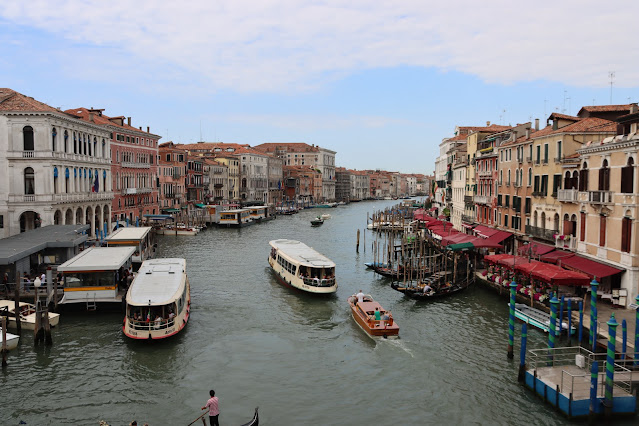 |
| Grand Canal |
 |
| Then main market just at the bus stop |
 |
| Peak-hour in Venice |
On the first visit, Kris and I followed a winding path towards St Mark's Square, stopping whenever we saw something interesting. We then had to race back through the city to catch the last bus back to Marghera (at 9pm). On the second visit, we led the kids through the backstreets to get to St Mark's Square early and avoid the crowed. We then wandered back past a few of the sights we had missed.
The photos above give a pretty good picture of our wanderings and the feel of the city. Below I will show some of the specific buildings and areas we saw.
The first was the Scoletta dei Calegheri - the historic school of shoemakers in Venice. The bell tower of the Frai is visible behind it. The school was founded in 1383
Next was the Church of Saint Roch (Chiesa di San Rocco) a Roman Catholic Church built in 1489, but modified in 1725. It is one of the plague-churches of Venice. The plague churches are a series of churches built in Venice after a massive outbreak of the Black Death plague in 1630-1631. Over 30% of the inhabitants of the city (46,000 people) died, including the ruler Nicolò Contarini, the Doge of Venice. The surrounding towns lost over 100,000 people. The religious in Venice prayed to the Virgin Mary to spare them and built or renovated a series of churches either as a plea to be spared or as thanks for surviving the plague.
One of the major parts of Venetian culture is the masks. The masks were originally created for Venice Carnival, allowing festival goers to hide their identities in the celebrations as well as the disguise those who were misbehaving. The masks are ornate and often used as a status symbol - they are usually handmade of layers of paper-mache built around a clay mold. There are four traditional mask types:
1) The Servants (Zanni) - characters like Arlecchino (Harelquin), Brighella, Pulcinella and Pedrolino (shown below in order from left to right):
2) The Old Men (Vecchi) - characters such as Pantalone and il Dottore
3) The Lovers (Innamorati) - such as Flavio and Isabella
4) The Captains (Capitani)
The mask stores were amazing:
 |
| The mask Tom bought |
One issue we ran into, was that Venice is split by the grand canal. There weren't a lot of bridges crossing it, so we found that we needed to use a Vaporetto or water taxi to cross. These were fairly expensive and very busy, so instead Kris and I went via a gondola, which ticked two boxes - Ride a Gondola in Venice and get across the canal. It cost 2 euro for the crossing, which took about a minute so was much cheaper than a 60min gondola ride at 90 euro. We came back via the Rialto bridge. When we came with the boys we decided to do the same, so they could experience it:
 |
| The issues of taking photos when your brother is wearing the camera... |
Once we crossed the Grand Canal, we came to the statue of Niccolò Tommaseo, in Campo Santo Stefano (The Square of St Stefano). Tommaseo was an Italian linguist and journalist from the Dalmatia region (1802-1874):
We then passed the Scuola Grande di San Teodoro (Grand School of Theodore), dedicated to Saint Theodore, the first patron saint of Venice. The School was built in 1580 by a group of merchants and artisans as a charity offering education. Over time its purpose changed - to a warehouse for storing flour, a homeless shelter, an archive and finally a theatre.
Then the Teatro La Fenice (The Phoenix Opera House), built in 1792 and reopened in 1837 and 2003 both times after being damaged by major fires, including a third fire during construction in 1774 - hence the name The Phoenix - rising from the ashes.
From there we made it to St Mark's Square (Piazza San Marco), the main public square in Venice. There are many points of interest in the square - St Mark's Basilica, The Carta Gate St Mark's Clocktower, The Columns of San Macro and San Teodor, St Mark's Campanile, Loggetta Sansovino, The National Archaeological Museum, Biblioteca Nazionale Marciana and the Doge's Palace.
We entered the square from the top left cotner, near where "Negozio Olivetti" is shown. To our immediate right (left of the picture) was the Museo Correr (National Archaeological Museum) - given to the city in 1830 by Teodoro Correr, a Venetian Abbot and Art Collector.
Facing the other way, towards the Basilica, we could see most of the main square:
On the north side of the square was the Clock Tower
Built in the 1490s, the tower is in the Renaissance style and was originally designed to allow people in the harbour to see the clock and know the wealth of Venice.
The top of the tower has a bell with two figures that strike it on the hour. Below is the blue section with the winged lion with its paw on a book. This is the Lion of Saint Mark, representing St Mark the Evangelist. Originally there was a statue of the Doge, Agostino Barbarigo, kneeling in front of the statue but this was removed by Napoleon's forces when they took the city.
Below the lion is a statue of the Virgin and Child with panels showing the time in Roman numerals. On the Epiphany and Ascension day, panels open under these numbers and three magi statues cross the platform and bow to the child.
Below this is the main clockface with a Zodiac pointer as well as a moon phase indicator. Then is an arch that leads to Merceria Street.
The main sight in the square is the Basilica of St Mark, formally known as the Patriarchal Cathedral Basilica of Saint Mark. It was consecrated in 1094 and is the third church to sit in that location. The design is based on the Church of the Holy Apostles in Constantinople, some of the columns, sculptures and reliefs were actually taken from Constantinople by the Venetians and brought back to be used.
Directly in front of the Basilica is St Mark's Campanile, the bell tower of Venice. This one was built in 1912 after the previous tower collapsed. It is the tallest structure in Venice at 98.6m and was originally intended as a watch tower to protect the harbour and to guide Venetian ships in. The bottom of the tower is the Loggetta del Sansovino, an exterior gallery that formed a gathering place for nobles.
 |
| Loggetta del Sansovino |
Looking back towards the Basilica from the harbour there are a few buildings visible:
 |
The Campanile can be seen at the back, as well as the top dome of St Mark's Basilica. On the left is the National Library (Biblioteca Nazionale Marciana) and on the right is the Doge's Palace.
The Doge was the duke of Venice and his palace is a Venetian Gothic palace built in 1340. Venice became the seat of the Doge in 810, but the palace built at that time was completely destroyed by fire. A second palace / fortress was built in 1172 for Doge Sebastinao Ziani. The palace was changed in the 1200s due to the need for more room for the expanding Great Council, so the current palace started construction in 1304:
 |
| " Bad Lion - get off my book" |
 |
| Doge's Palace |
Between the Doge's Palace and the Basilica is the Carta Gate (Porta Della Carta), possibly the original entrance to the Palace:
On the right side (looking back towards the Basilica) is the Biblioteca Nazionale Marciana (Library of Saint Mark), founded in 1468:
The final feature was the Column of San Marco and San Teodoro. The Column of Saint Mark (San Marco) holds the lion symbol of Saint Mark and the Column of Saint Theodore (San Teodoro) holds a statue of the first Patron Saint of Venice (who was replaced by Saint Mark):
Looking out over the harbour, several churches are visible:
The Church of San Giorgio Maggiore (San Zorzi Mazor) was started in 1566 and completed in 1610. It is a Benedictine church in Classical Renaissance Style. The island is named San Giorio Maggiore and was gifted to the Benedictine monks by Doge Tribuno Memmo in 982. A monastery was built, but destroyed in an earthquake in 1223. The church and monastery were rebuilt after the earthquake but redesigned in the 1500s to become to current design.
On the other side is the Basilica Santa Maria della Salute (Basilica of Saint Mary of Health), a Roman Catholic Church which sits on a narrow strip of land between the Grand Canal and Giudecca Canal:
The church was consecrated in 1681 as a major plague-church. The church was dedicated to Virgin Mary who was seen as the protector of Venice and the senate visited the church every year on the 21st of November to celebrate the end of the plague.
We then walked along the harbour, past all the people taking Instagram model shots, including a lady who was touching up her makeup and pulling cans of hairspray out of her bag as she got ready to pose.
We passed the Palazzina Selva:
and the Chiesa Parrocchiale di San Moisè, a Roman Catholic Baroque church built in 600s and with a Baroque façade from 1668:
We then needed to cross back over the Grand Canal, so we found the Ponte di Rialto (Rialto Bridge). The oldest of the four bridges across the Grand Canal, the Rialto bridge was first built in 1173, but the current design is from 1588:
 |
| Kristine in the eternal hunt for a better photo... |
On the first evening this is where Kristine and I stopped for dinner and then started our speed walk back to the bus. We ended up with a pizza at the Al Theatro, which was reasonably priced. Any good Italian will tell you not to get pizza in Venice, as the city regulations prevent wood fire oven, but our pizzas were nice:
With the kids, we managed to get to a few more places:
Chiesa di San Simeon Piccolo - constructed in 1738:
Next up was the church of San Giovanni Evangelista, built in 1425 and repaired in 1645 and recently after earthquake damage:
One of the towers visible throughout Venice is the Tower of Santo Stefano. The tower has a distinct lean due to the subsidence of its foundations during construction. It is 61m tall and was originally built in the 12th century and rebuilt in 1585 after a fire which melted its bells and destroyed the top of the tower:
We then passed the Basilica Santa Maria Gloriosa dei Frari, the largest church in the city, known as the Frari. The church was concecrated in 1469:
Then the Santa Maria di Nazareth Church (Scalzi), built in 1680_
Then the Chiesa di Sant'Aponal (Church of Sant'Asponal) built in the 11th century by Ravenna refugees. It was deconsecrated during the Napoleonic occupation and was used a prison for political prisoners and is now used as an archive.
San Silvestro, built in 12th century, rebuilt in the 1400s and again in 1820. The façade was completed in 1902:
Our final stop was the Piazza Manin (Manin Plaza) and the statue of Manin and Lion. This was a square to honour Daniele Manin, an Italian Patriot and Statesman (1804-1857):




































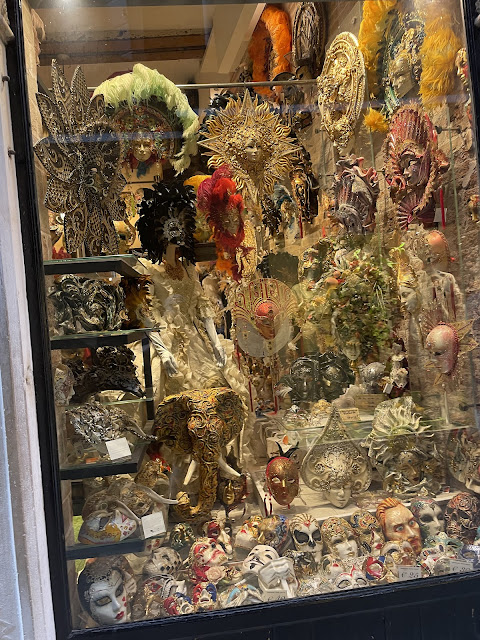
















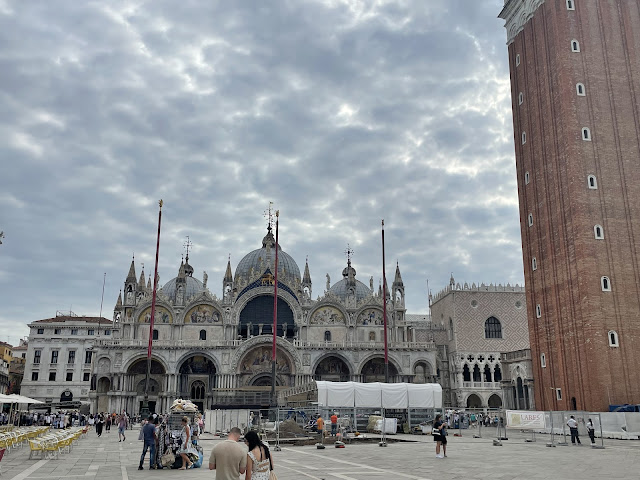




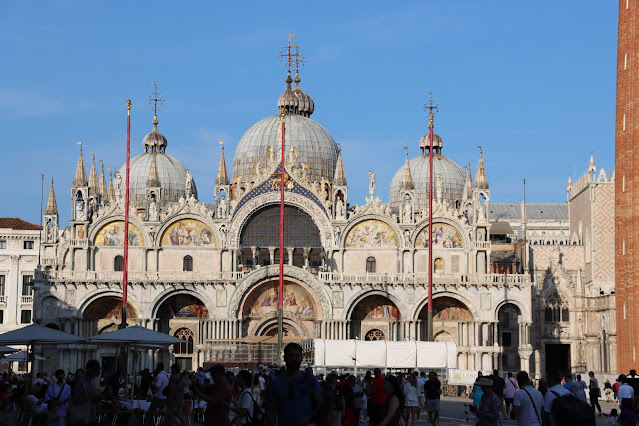




































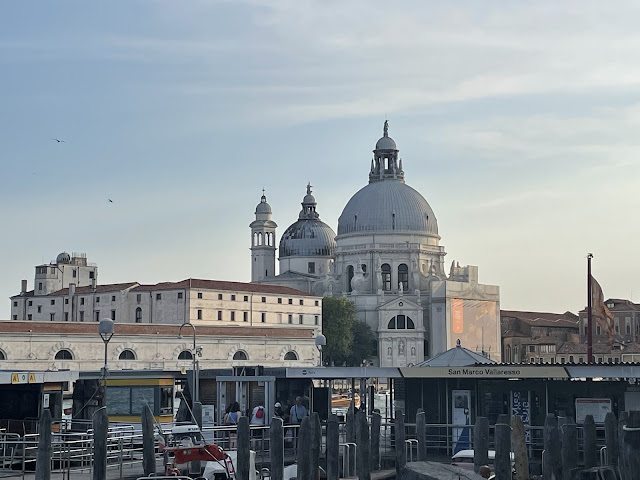






























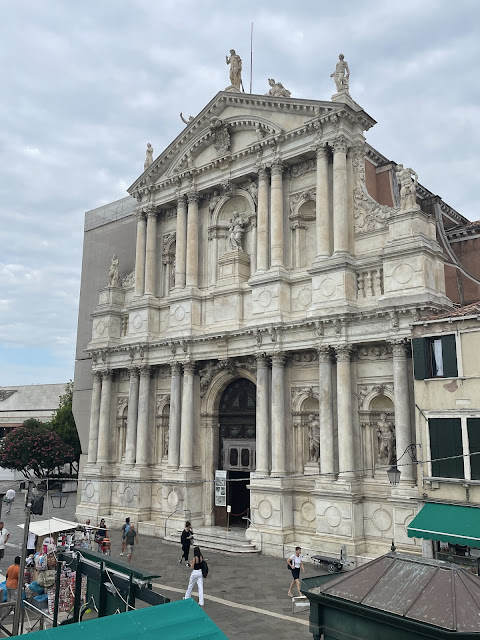




No comments:
Post a Comment